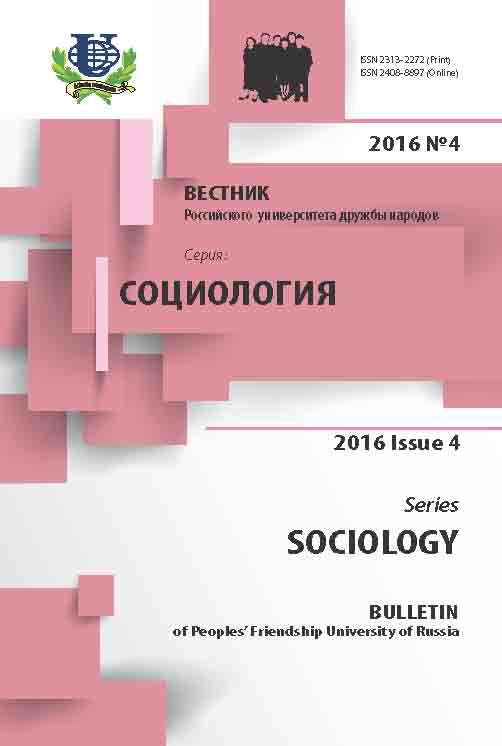The voluntary work based village activism in contemporary Finland
- Authors: Kopoteva IV1
-
Affiliations:
- Russian Presidential Academy of National Economy and Public Administration
- Issue: Vol 16, No 4 (2016)
- Pages: 789-798
- Section: Contemporary society: the urgent issues and prospects for development
- URL: https://journals.rudn.ru/sociology/article/view/14811
- ID: 14811
Cite item
Full Text
Abstract
The article considers the voluntary based village activism in contemporary Finland. The author sees the roots of nowadays village activism in the traditional voluntary work: cultivation of common fields called for cooperation, and decision making on common issues required organisation of village meetings to make a collective decision. As a large social movement the village activism started in 1970s in the course of protest actions driven by the diminishing rural population and abandonment of arable lands. A large-scale establishment of village committees was also determined by the reduction of importance of traditional rural productive cooperation and by the changing role of countryside in the era of industrialisation. Nowadays Finland has a well-developed system of village associations, and its structure consists of three levels: village level, regional level and national level. At the local level, there are more than 4200 villages. In 2013, about 3100 villages had a registered village association and about 930 villages had a non-registered village association. Approximately 200 villages in Finland still do not perform any village activities of the considered type. As a rule, village activism generates in response to the specific needs of the village and aims to guarantee its residents’ well-being. At the regional level, there are 19 regional village associations. The most important tasks for the regional rural organisations are to ensure the villages’ interests and to work as a cooperative body for the rural development at the regional level. The top of the system under consideration is the Village Association of Finland. It is an umbrella organisation for the state, regional and local rural actors. The current development of rural movement in Finland could be evaluated in the framework of several theoretical conceptions: social capital and networking, entrepreneurial culture, and institutionalisation.
About the authors
I V Kopoteva
Russian Presidential Academy of National Economy and Public Administration
Author for correspondence.
Email: inna.kopoteva@gmail.com
Moscow, Russia
References
- Alapuro R., Stenius H. Kansanliikkeet loivat kansakunnan. Teoksessa Risto Alapuro, Ilkka Liikanen, Kerstin Smeds & Henrik Stenius (toim.) Kansa liikkeessä. Jyväskylä: Gummerus, 1987.
- Anttila V. Kyläyhteisöjen kulttuurinen integraatio. Teoksessa Päiviö Tommila ja Ismo Heervä (toim.) Muuttuva kylä. Vaasa: Suomalaisen kirjallisuuden seura, 1980.
- Dean M. Governing the unemployed self in an active society. Economy and Society. 1955. Vol. 24. No. 4.
- Harvey D. Uusliberalismin lyhyt historia. Tampere: Vastapaino, 2008.
- Holmila M. Kylä kaupungistuvassa yhteiskunnassa. Yhteisöelämän muutos ja jatkuvuus. Helsinki: Suomalaisen kirjallisuuden seura, 2001.
- Hyyryläinen T. Toiminnan aika. Tutkimus suomalaisesta kylätoiminnasta. Vammala: Line Sixtyfour Publications, 1994.
- Katajamäki H. Suomen maaseudun evoluutio. URL: www.ruralstudies.fi.
- Kumpulainen K. Village Action and the Production of an Active Village. Jyväskylä: University of Jyväskylä, 2012.
- Kumpulainen K. Kun pienestä kunnasta tulee kylä. Kuntaliitosten vaikutukset maaseutuyhteisöissä. Työ- ja elinkeinoministeriön julkaisua. Alueiden kehittäminen. 2014. No. 33.
- Putnam R.D. Making Democracy Work. Civic Traditions in Modern Italy. Princeton: Princeton University Press, 1993.
- Ray C. Neo-endogenous development in the EU.P. Cloke, T. Marsden, P.H. Mooney (eds.). Handbook of Rural Studies. London: Sage, 2006.
- Saastamoinen M. Riskitodellisuus ja aktiivisen kansalaisuuden ihanne. Teoksessa Mikko Saastamoinen & Pekka Kuusela (toim.) Kansalaisuuden ääriviivoja. Hallinta ja muodonmuutokset myöhäismodernilla ajalla. Helsinki: Yliopistopaino, 2006.
- Uusitalo E. Finnish rural policy and local initiatives. Finnish Journal of Rural Research and Policy. 1999. No. 2.
Supplementary files













